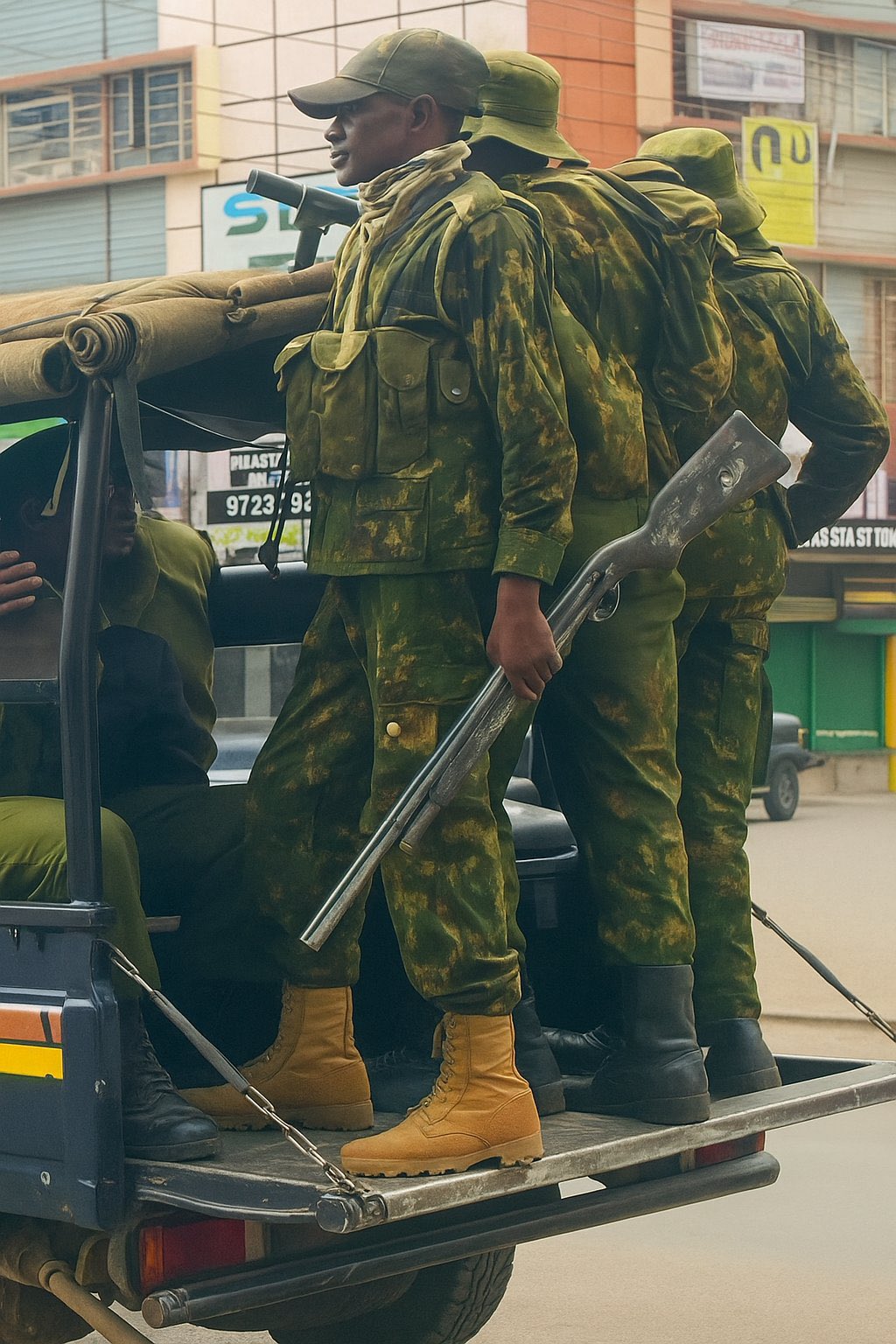In Greek mythology, Pandora, driven by curiosity, opened a forbidden box, unleashing plagues, sorrow, and chaos upon humanity, leaving only hope trapped inside. Once opened, the box’s evils could not be contained, a cat irrevocably let out of the bag. On June 17, 2025, the Kenyan state, through its response to protests in Nairobi and Mombasa, appeared to open its own Pandora’s box, unleashing anarchy that spiraled beyond control. The demonstrations, sparked by the death of teacher and blogger Albert Ojwang in police custody the previous week, exposed a state apparatus marked by callous indifference, mechanical policing, and alleged collusion with hired goons, plunging the nation into a day of violence, defiance, and fleeting triumphs.
Protests Fueled by Albert Ojwang’s Death
The protests in Nairobi’s Central Business District (CBD) on June 17 were a direct continuation of demonstrations that began the previous week following the death of Albert Ojwang, a high school teacher and outspoken blogger. Ojwang, arrested in Homa Bay County for criticizing Deputy Inspector General Eliud Lagat, was found dead in custody, with reports of torture fueling public outrage. His killing reignited demands for justice and an end to police brutality, echoing the 2024 Gen Z protests that shook Kenya’s political landscape. Protesters, carrying placards with slogans like “Stop Killing Us” and “Justice for Ojwang,” marched through Nairobi’s streets, targeting key locations like Moi Avenue, Tom Mboya Street, and the National Archives.
The irony of the day’s events was stark. During a demonstration against police violence, a peaceful non-protester—a street vendor selling face masks—was shot at close range by a police officer. At approximately 2:00 p.m. on Moi Avenue, in front of multiple cameras, including Citizen Television’s, two policemen struck the vendor on the head before one fired a long-barreled gun as the man attempted to walk away. The vendor collapsed, clutching a packet of face masks, blood pooling from a severe head wound. This act, captured on video and shared widely on X, encapsulated the naked callousness of a state seemingly indifferent to its citizens’ lives. The mechanical response of the police—striking and shooting without apparent hesitation—underscored a lack of awareness or restraint, amplifying accusations of arrogance and impunity.
The vendor’s identity remains mired in confusion. Some reports named him James Mugo, others Eli Joshua, and a third name of Ali, possibly a nickname. Adding to the uncertainty, unverified accounts on X suggested a second shooting, linking the name Eli Joshua to a man allegedly shot at close range in a separate incident. Initial reports claimed the Moi Avenue vendor was killed, but tweets from first responders stated he was alive but critical at in hospital, suffering from gunshot wounds, head injuries, blunt force trauma, whiplash, and asthma triggered by tear gas. As of June 18, 2025, the vendor’s name, survival status, and the existence of a second victim remain unconfirmed, reflecting the chaotic pace of news on a day of anarchy.
Goon Involvement
The protests’ descent into anarchy was exacerbated by the involvement of suspected state-sanctioned goons, whose actions were documented on camera and linked to high-profile backers. Days before the demonstrations, videos circulated on social media platforms showing groups of young men, armed with whips and rungus (clubs), warning protesters to stay away from Nairobi’s CBD. On June 15, an informal press conference held outside the Nairobi County offices featured individuals claiming to represent “local youth” who vowed to “protect the city” from unrest. These warnings foreshadowed the chaos that unfolded.
Around 10:00 a.m., goons, reportedly transported from slums like Majengo and Shauri Moyo on motorbikes, infiltrated the protests. Armed with knives, whips, and crude weapons, they attacked protesters, looted shops, and robbed civilians across Koinange Street, Mfangano Street, Tom Mboya Street, Ronald Ngala Street, River Road, Wabera Street, and Kenyatta Avenue. At Tumaini Supermarket and Market Plaza, goons broke into stores, stealing goods. On Kimathi Street, they chanted “Hakuna maandamano” (no protests), with some openly mentioning their backers. A widely circulating video posted by major news networks as well captured goons saying, “Sakaja tumelinda jiji” , referring to Nairobi Governor Johnson Sakaja. Other footage showed anti-riot police escorting armed gangs, prompting accusations of state collusion.
The use of goons to suppress protests is not new in Kenya. In the 1980s and 1990s, state-sanctioned violence under the Moi regime, often through hired thugs, targeted pro-democracy activists. This strategy backfired, contributing to the formation of gangs and terrorist organizations like Mungiki, which evolved from marginalized youth into criminal networks. Human rights activist Caleb Okumu, from the Centre for Good Governance, noted this historical parallel, citing similar police-goon alliances during the 2023 Azimio and Saba Saba protests. Maurice Okwiri, an MCA from Majengo, Shauri Moyo, acknowledged the goons’ presence but denied their protest involvement, fueling speculation of organized disruption. The Kenya National Chamber of Commerce and Industry, led by Dr. Bernard Chanzu, reported significant business losses from looting and closures, while city vendors’ chairperson John Njau condemned the police-goon alliance.
Witnesses, including trader David Obuon and lawyer Nicholas Kitonga, reported police and goons extorting money from vendors, with incidents at Afya Centre and the Country Bus Station. Activist Hanifa Adan, a 2024 Gen Z protest leader, described being overwhelmed by goons wielding whips while police stood by, as shared in her X post. The anarchy caused gridlock on Haile Selassie Avenue, Kenyatta Avenue, University Way, Mombasa Road, Thika Superhighway, and Jogoo Road, with Nairobi County’s new black dustbins vandalized.
The rapid spread of information led to unverified claims that clouded the narrative. Beyond the vendor’s uncertain identity (James Mugo, Ali, or Eli Joshua) and survival status, some twitter posts alleged a second shooting, though no mainstream media corroborated this. Allegations of high-profile backers orchestrating the goons’ actions remained inconclusive, though footage of police escorting gangs lent credence to claims of state involvement. The National Police Service, under Inspector General Douglas Kanja, ordered the arrest of the officer who shot the vendor, identifying and detaining him by evening for arraignment on June 18, 2025, on murder charges. However, no photographic evidence of the officer’s arrest has surfaced, leaving some Kenyans skeptical.
Mombasa Demonstrations and Arrests
In Mombasa’s Central Business District, protests on June 17 were held in solidarity with Nairobi, focusing on Albert Ojwang’s death and systemic police brutality. Unlike Nairobi’s anarchy, Mombasa’s demonstrations were relatively peaceful, though police intervened to prevent escalation. Youths and activists marched from Kibarani Market to Tom Mboya Street, carrying placards demanding justice. A petition was presented to the Independent Policing Oversight Authority (IPOA) office, calling for investigations into Ojwang’s killing and an end to police impunity. The protests highlighted ongoing human rights violations in Majengo, with 10 documented cases of enforced disappearances and extra-judicial killings in 2014.
Four protesters were arrested near Central Police Station for holding an “illegal” demonstration but were released on bond. Among those detained were individuals linked to the Communist Party of Kenya, known for its vocal criticism of state repression. Police chief Edwin Okello emphasized the need for prior protest notification, citing constitutional rights to peaceful assembly. Security remained tight, preventing the chaos seen in Nairobi.
Key voices included Ali Said, a Kisauni Chief Steward, who expressed community grief; Andrew Mwinzi, Pwani University Students Association leader, who demanded broader investigations; Mwero Msagha, from Muslims for Human Rights (Muhuri), who criticized police impunity; and Harun Kwamboka, Mombasa County Bunge la Wananchi Chairperson, who supported the IPOA petition. The Law Society of Kenya (LSK), Mombasa chapter, condemned police misconduct. X users praised the protesters’ discipline, reinforcing calls for Deputy Inspector General Eliud Lagat’s resignation by June 25, 2025, the anniversary of the 2024 Gen Z protests.
Triumphs Amid Anarchy
Despite the chaos, June 17 witnessed moments of triumph that underscored Kenyan resilience. In Nairobi, protesters and bystanders rushed the shot vendor to Kenyatta National Hospital for emergency surgery, a display of solidarity celebrated on X. Legitimate CBD-based boda boda riders allied with protesters, clashing with goons transported from slums. A goon’s motorcycle was set ablaze on Moi Avenue, as reported by multiple users including activist Nyamisa Chelagat, symbolizing defiance. These acts of resistance were amplified online, with highlighting the boda boda community’s courage.
A significant triumph was the use of Open-Source Intelligence (OSINT) by ICT experts on X. OSINT involves collecting and analyzing publicly available data—videos, photos, social media posts, and geolocation metadata—to uncover hidden truths. By 7:00 p.m., activists identified the officer who shot the vendor within five hours of the 2:00 p.m. incident, using footage from Citizen Television and bystander videos. This rapid identification, shared widely on X, was hailed as a victory for digital activism, exposing police misconduct in real-time. However, while Inspector General Kanja confirmed the officer’s arrest, the absence of photographic evidence as of June 18, 2025, has fueled skepticism.
The protests’ broader impact was undeniable. Hashtags like #JusticeForAlbertOjwang, #EndPoliceBrutalityKE, and #TuesdayisTuesday trended. The anarchy coincided with the 2025 Finance Bill debate in Parliament, intensifying calls for systemic reform. Anti-riot police fired tear gas and rubber bullets near the National Archives, Kimathi Street, and Nation Centre, injuring at least 21 people with gunshot wounds, head cuts, whip lashes, blunt trauma, and tear gas-related asthma.
The events of June 17, 2025, in Nairobi and Mombasa revealed a state grappling with its own unleashed chaos. The shooting of a non-protesting vendor during a demonstration against police brutality laid bare the state’s callous indifference. The goons’ anarchy, captured on camera and linked to unverified backers, echoed Kenya’s troubled history of state-sanctioned violence. Mombasa’s restrained protests underscored a national demand for accountability, while triumphs like OSINT breakthroughs and civilian solidarity offered glimmers of hope. As Kenya approaches the June 25, 2025, anniversary of the 2024 Gen Z protests, the state’s Pandora’s box remains open, its anarchy threatening to engulf a nation yearning for justice.
Written by Otieno Arudo




